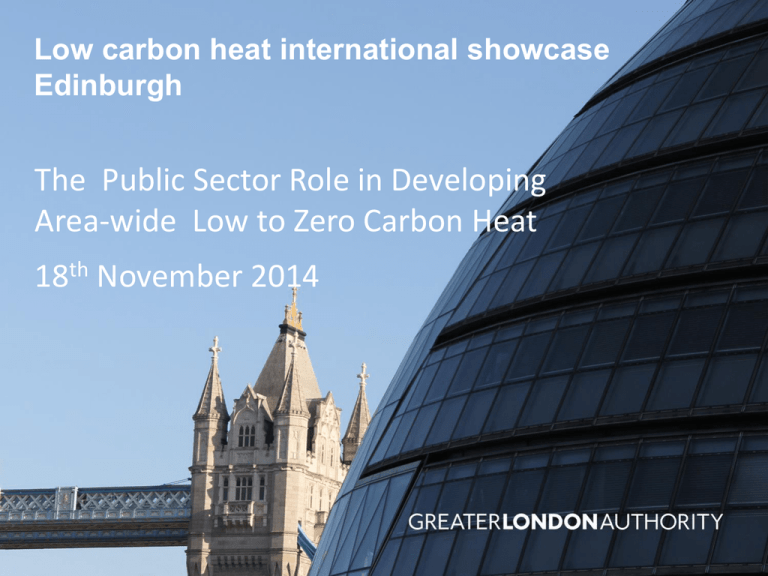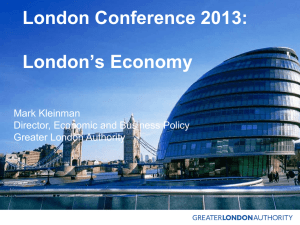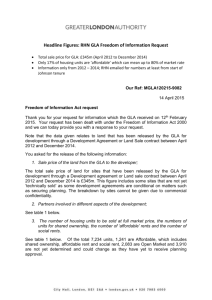part 2 - B2Match
advertisement

Low carbon heat international showcase Edinburgh The Public Sector Role in Developing Area-wide Low to Zero Carbon Heat 18th November 2014 The London Heat Map (www.londonheatmap.org.uk, 2011) The London Heat Map is an interactive tool that allows users to identify opportunities for DE projects in London. - It is owned by the GLA since 2011 - It builds on the 2005 London Community Heating Development Study - It is in a user friendly format using an interactive GIS system - It provides spatial intelligence on factors relevant to the identification and development of DE opportunities, such as major heat loads and supply plants, heat networks, DE clusters, OAPFs, etc. - It is publicly accessible to anyone with an interest in DE The heat mapping exercise has been completed for the London Boroughs in March 2012. 31 Heat Map reports are available for download. Decentralised Energy Masterplanning Programme (2011) The Mayor of London is providing financial and technical support to London Boroughs in the production of local Energy Masterplans. Masterplans are developed to: -Identify new DE opportunities in an area -Set out a long-term vision for the heat networks growth -Develop planning policies to promote heat networks and the connection of new developments to those networks Masterplans must include: -Phased construction of new developments -Initial proposals for pipe routes and plant locations -Outilne economic and environmental impacts of their implementation To date, 10 Energy Masterplans have been completed and are available to download at the London Heat Map website, whilst 5 are underway. Upper Lee Valley Opportunity Area Energy Strategy EOn 400MWe Enfield Power Station (~12MWth potential LP steam) ~7.5km Johnson Matthey Industrial Plant (potential low grade heat rejection & existing CHP) Proposed Gasification Plant (potential for ~10MWth) Broadwater Farm LWL Edmonton EcoPark (~18-60MWth; 8-23MWe) Figure 4.3.1 British Waterways land available for potential DHNHeating main corridors District Network Option: British Waterways Corridor Figure 4.3.2 Network Rail land available for potential DHNDistrict main corridors Heating Network Option: Network Rail Corridor Decentralised Energy Project Delivery Unit (2011) DEPDU provides technical, financial and commercial advisory services to help others develop and bring to market larger scale DE projects -€3.3m funding (90% from the European Commission’s ELENA technical assistance facility, 10% from the GLA) -Private and public sector support -Focus on heat network schemes supplied from CHP and sources of waste heat -Targets: projects with total investment of £60.5m to market by July 2014 (leverage ratio 25:1) To date the GLA has supported almost £40m of DE projects to market. The programme is actively supporting a pipeline of 18 DE projects, with a total investment potential of over £150m. Case Study – Gospel Oak DH (LB of Camden) - Heat network supplied by waste heat from a new 4.6MW gas turbine CHP installation at the Royal Free Hospital - 3.5MW GT heat recovery system, 1.3km heat network - System supplies existing housing estates (~ 1,500 units) - CAPEX: £5.7m - Project commissioned in 2012 - CO2 savings: 2,890 t/year - DEPDU role: assist LB Camden with initial feasibility, design and energy supply contract preparation Case Study – South Kilburn DE (LB of Brent) - Regeneration project - 2,400 new homes and related facilities and infrastructure - The LB of Brent is procuring a £15m sitewide heat network through an ESCo concession agreement - OJEU notice issued in 2011 and 3 bidders selected to be taken to the Invitation to Tender (ITT) stage - DEPDU role: assisting the LB of Brent with initial feasibility study, ESCo procurement process and development of a concession contract - Expected construction start date: 2015 - 3.1km heat network - 1.5MWe / 2.5MWth CHP - CO2 savings: 835 t/year (estimated) Case Study - Lee Valley Heat Network (North London) Pilot Projects – Islington’s Bunhill Phase 2 EU co-funded project, CELCIUS, aimed at demonstrating innovative solutions of using low temperature secondary waste heat to supply new and existing homes. Background information: -£3.8m CAPEX (£1.1m EU / £2.7m Islington) -GLA provides PM and technical support Waste heat recovery: -3 UKPN electrical transformers, oil cooled (~ 40-50°C) -LU mid-tunnel ventilation shaft, air (~ 15-25°C) Objectives: -Connect 500 existing homes and other new homes to the Bunhill heat network -Demonstrate technical viability and disseminate results Licence Lite Licence Lite is a simplified version of a standard electricity supply licence to enable “small” generators to enter the electricity supply market. -Started in 2009 when Ofgem published proposed changes to the standard conditions for electricity supply licences -Small generators can supply their electricity retail to any premises connected to the public electricity distribution system prospect of earning higher returns on the electricity they export -Example: export tariff ~4.5 p/kWh, retail price ~ 12-17 p/kWh -Objective: to enable CHP DE schemes to earn greater over-all returns on their energy generation thus becoming financially viable and capable of attracting investment. In March 2014, the GLA became the first authority in the country to apply to Ofgem for a Licence Lite. The GLA will: -Buy excess electricity produced by London’s boroughs and public bodies -Sell it on, at cost price (~10 p/kWh < retail price), to other public sector organisations, such as Transport for London, the Met Police and NHS hospitals. -Scheme could be extended it to include private sector energy producers. London’s Zero Carbon Energy Resource (2013) This study examines the availability and cost of ‘secondary’ heat sources in London and issues associated with their integration with heat networks. Focus: -Builds on Decentralised Energy Capacity Study -Waste heat arising as a by-product of industrial and commercial activities (e.g. data centres); -Heat that exists naturally within the environment (air, ground, water). Objectives: -To inform policy development and the market on the likely technical and economic conditions in which these sources may be viable; -To identify emerging project opportunities. Conclusions: -24% of London’s heat demand could be economically met by these sources when distributed via local heat and power networks. Contact Peter North Senior Manager Programme Delivery – Sustainable Energy Greater London Authority peter.north@london.gov.uk











